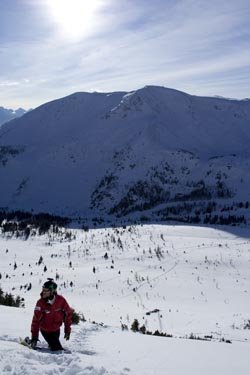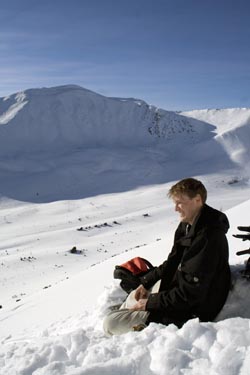Discovering the real reason behind Lake Louise’s international reputation
WILL COLFORD
LAKE LOUISE, AB — Alberta’s Lake Louise Ski Area has long been a draw for international visitors, most of whom ski the same areas that we all know and love. But there are others who have discovered the true in-bound treasures the Lake offers, and it's these rarely-accessed gems that cause them to keep coming back year after year.

Snowboard instructor, Jack Kuntze (JK) takes a breather in the middle of a hike up to some of Lake Louise's avalanche controlled backcountry-style terrain. |
A word from the wise, though: if you want to get into some of these unbelievable areas, you're going to have to work for it.
Three-year ski school veteran Jack Kuntze (JK) and I did two hikes during the day into this amazing terrain. The first, accessed off the top of the Larch Chair, is known appropriately as Elevator Shaft. Before we started, JK described the hike as "jumping on a StairMaster for a good while." What an understatement. I don’t smoke, I’m somewhat athletic, and I very nearly collapsed after the first five minutes of the boot pack.
Sweat equity
With it being only my second run of the day, the hike felt like it took forever. In truth, it was only 25 minutes before I threw in the towel. The top of the ridge could easily be seen, but I hadn’t yet gained that all-important motivation.
With a smirk, JK looked at me and said, “Fresh tracks, if you’re willing to hike.”
Elevator Shaft is a big face that funnels into two steep chutes that open into the Rock Garden and some nicely spaced glades. It was a great warm up for what was to come later.
After refueling with some lunch, it was time to tackle something more substantial. Standing on top of the mountain, we surveyed our options. “Well, we can head back up the Poma lift and traverse all way over to Brown Shirt, or do another Gully run,” suggested JK.
“What about that?” I asked, pointing directly across the backside at the opposing face.
“That’s Richardson’s Ridge,” said JK. “We can either do that boot-pack, or come around the corner on that switchback trail.”
The first boot-pack appeared to be almost straight up, but fairly straightforward. The second appears to be a bit easier and would take us into some glades.
“What’s the danger level?” I asked.
“Because it’s within the tree line, it should be moderate right now, but we’ll have a dig around when we get there.”
Questioning the decision
We decided to save our legs and take the easy way down to the start point for the first boot-pack. It didn’t go to the top of the ridge, but comprised most of the face. Just getting to the base of the boot-pack was challenging, as waist deep snow and constantly breaking through the top crust turned a walk in the park into a trudge through the drift.
“Maybe we should have packed a bottle of water,” I said, remembering our previous hike, equally as unprepared. Once at the base of the hike, so close but so far away from the cat track, it was clear we’d face three sections: a straight up boot-pack would be followed by negotiating through some shrubs, tree tips, and steeps, then, a final switch back to the top of the face.
Approximately half an hour in and a little over half way up, I began to wonder if the price of a lift ticket was worth it. At that moment, I didn’t feel like having all this terrain was really worth it for the average rider or skier, who wouldn't go to such lengths to access it. Moreover, JK and I were following a previously broken trail and the tracks revealed that the first people to do the hike that day needed to use their boards like axes, lifting then digging in to get some leverage for every single step.
At long last we arrived at the top, and we both began to giggle. JK did a quick cut block test to check the danger level of the snow pack.

SnowSeeker scribe, Will Colford sits and just takes in the incredible views and epic terrain at Alberta's Lake Louise Ski Area. |
“This base layer isn’t going anywhere, but there’s two layers on top of that.”
“What about the sunshine?” I inquired. It was May weather in January. The sun lifted my spirits at the peak, but made for an extra sweaty trek.
“True, a sunny day can change the pack. The danger comes when you have a sunny day that melts and settles the top layer, then it freezes over night and creates a solid slab on top of a lucid second layer. This is the first warm day, so the face could really be dangerous tomorrow, but its good right now. Just don’t lay one in too deep.”
I was comforted that JK went first.
Words aren't enough
After my first two test turns, any thoughts of danger disappeared and gave way to absolute euphoria. The only sounds were the soft glides from our boards, and the howling laughter from our mouths. JK hit a double drop as I pulled a wide slash down the face. Opposite to us were hundreds of jealous onlookers.
An hour-long hike for about a minute of riding; the moment is fleeting but the feeling lasts forever. JK and I laughed all the way down and when we finally stopped, we stoodd in silence and just enjoyed the feeling. Looking back at our run, JK asked, “Want to go again?”
“That was one of the best runs of my life,” I said. I've been skiing and riding since I was seven years old, so the statement carried some weight. "Of course I want to go again!"
“Completely,” agreed JK, no stranger to fresh tracks. Then he nailed why Lake Louise has terrain like that. “If you were here for even a few days and the rest of the hill had average conditions, all it takes you is an hour to do just one of those runs and you get the best run of your life."
After calming down and hopping on the lift, we looked back and traced our tracks. We had left our mark for everyone else to see.
For me, those runs were worth any price.
For more on Lake Louise Ski Area, visit www.skilouise.com.